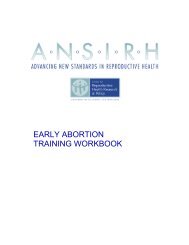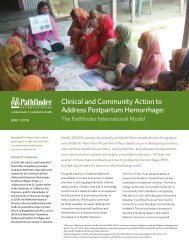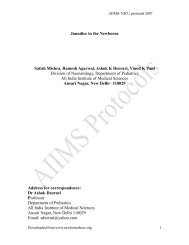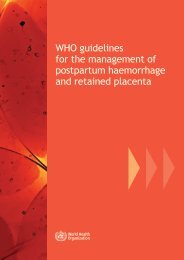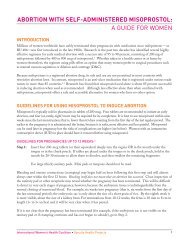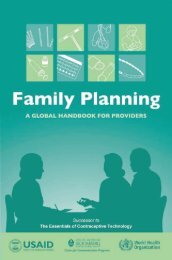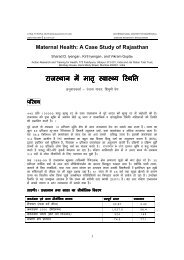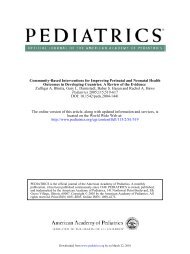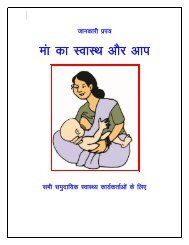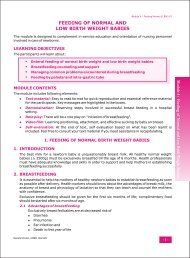Uterine evacuation with manual vacuum aspiration ... - CommonHealth
Uterine evacuation with manual vacuum aspiration ... - CommonHealth
Uterine evacuation with manual vacuum aspiration ... - CommonHealth
Create successful ePaper yourself
Turn your PDF publications into a flip-book with our unique Google optimized e-Paper software.
The Courses<br />
The three courses vary in length and scope and can be offered separately or in<br />
a series so that participants can attend more than one course in a convenient<br />
timeframe. The basic course themes are:<br />
• MVA and its clinical applications;<br />
• How to perform MVA on a pelvic model and all local instrument processing<br />
options (where regulatory conditions approve re-use);<br />
• The above topics plus supervised clinical practice, management of<br />
complications and guidance on monitoring of services.<br />
Training facilitators should select course materials based on the environmental<br />
context in which the learners will put their new knowledge and skills to use. The<br />
two key issues of environmental context to identify for course content selection<br />
are:<br />
1. Clinical applications for<br />
use of MVA<br />
In every country of the world, there are at least two clinical applications for MVA: treatment of incomplete or missed abortion<br />
(miscarriage) and endometrial biopsy. Additionally, in most countries, therapeutic abortion is legally permitted to save the<br />
woman’s life or preserve her health and/or for other indications. Most women live in countries where induced abortion is<br />
permitted, <strong>with</strong> or <strong>with</strong>out restrictions (CRLP 2007).<br />
Materials on the CD-ROM included <strong>with</strong> this <strong>manual</strong> are labeled <strong>Uterine</strong> Evacuation for either<br />
• INCOMPLETE/MISSED ABORTION: for use in contexts that focus on treatment of incomplete/missed abortion, whether<br />
miscarriage management or treatment of complications of an induced procedure, and endometrial biopsy<br />
• Or, ALL INDICATIONS: for contexts that include treatment of incomplete/missed abortion, first-trimester induced abortion<br />
and endometrial biopsy<br />
2. Regulatory Context: Are<br />
cannulae labeled for<br />
single or multiple use?<br />
The use and re-use of cannulae varies among countries and clinical practices. In the United States and some other countries,<br />
Ipas EasyGrip ® cannulae are labeled for single use and should be discarded after use. Where local regulations permit, these<br />
cannulae can be reused after high-level disinfection or sterilization. Please note that flexible Karman cannulae and 3mm<br />
cannulae for endometrial biopsy are labeled for single use in all countries and should be discarded after use.<br />
Trainers should plan to follow country-specific labeling regarding single-use or processing of instruments for reuse. Materials<br />
on the CD-ROM included <strong>with</strong> this <strong>manual</strong> are labeled either<br />
• SINGLE USE: for settings where cannulae are used once and discarded<br />
• Or, MULTIPLE USE: for settings where cannulae are processed for reuse<br />
UTERINE EVACUATION WITH MANUAL VACUUM ASPIRATION (MVA): A TRAINING MANUAL FOR CONDUCTING SHORT COURSES · 3



